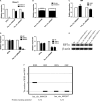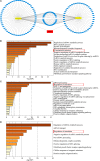Circular RNA screening from EIF3a in lung cancer
- PMID: 31197975
- PMCID: PMC6675731
- DOI: 10.1002/cam4.2338
Circular RNA screening from EIF3a in lung cancer
Abstract
Eukaryotic initiation factor 3 (EIF3) is one of the largest and most complex translation initiation factors, which consists of 13 subunits named eukaryotic translation initiation factor 3 subunit A (EIF3a) to EIF3m. EIF3a is the largest subunit of EIF3. Previous studies suggested that EIF3a is a housekeeping gene, recent results have found that EIF3a is closely related to the tumorigenesis and drug resistance. Circular RNAs (circRNAs) derived from biologically important gene can play an important role in gene regulation. However, the mechanism underlying circRNAs' biological functions is not well understood yet. In this work, we screened 31 EIF3a-derived circRNAs, in which two circEIF3as were identified to be correlated with cisplatin drug sensitivity in lung cancer. Two circEIF3as were found involved in RNA-binding proteins-mediated biological processes and may be related to translational regulation according to bioinformatics analyses. CircEIF3as, the transcriptional initiation factor EIF3a transcribed circRNAs, are associated with both drug sensitivity and translation regulation. These findings mean that they may have a functional synergy effect with EIF3a or be valuable therapeutic targets for treatment like EIF3a. This is the first study that exploits circRNAs screening from EIF3a in lung cancer, our findings provide a novel perspective on the function of EIF3a and circEIF3as in lung cancer.
Keywords: EIF3a; bioinformatics; circular RNA; lung cancer.
© 2019 The Authors. Cancer Medicine published by John Wiley & Sons Ltd.
Conflict of interest statement
The authors declare no conflict of interest.
Figures





Similar articles
-
eIF3a improve cisplatin sensitivity in ovarian cancer by regulating XPC and p27Kip1 translation.Oncotarget. 2015 Sep 22;6(28):25441-51. doi: 10.18632/oncotarget.4555. Oncotarget. 2015. PMID: 26213845 Free PMC article.
-
The translational regulator eIF3a: the tricky eIF3 subunit!Biochim Biophys Acta. 2010 Dec;1806(2):275-86. doi: 10.1016/j.bbcan.2010.07.005. Epub 2010 Jul 17. Biochim Biophys Acta. 2010. PMID: 20647036 Review.
-
Individual overexpression of five subunits of human translation initiation factor eIF3 promotes malignant transformation of immortal fibroblast cells.J Biol Chem. 2007 Feb 23;282(8):5790-800. doi: 10.1074/jbc.M606284200. Epub 2006 Dec 14. J Biol Chem. 2007. PMID: 17170115
-
Aberration in translation initiation and associated diseases: Role of the eukaryotic translation initiation factor 3A.Zhong Nan Da Xue Xue Bao Yi Xue Ban. 2017 Oct 28;42(10):1204-1211. doi: 10.11817/j.issn.1672-7347.2017.10.013. Zhong Nan Da Xue Xue Bao Yi Xue Ban. 2017. PMID: 29093254
-
eIF3: a factor for human health and disease.RNA Biol. 2018 Jan 2;15(1):26-34. doi: 10.1080/15476286.2017.1391437. Epub 2017 Nov 13. RNA Biol. 2018. PMID: 29099306 Free PMC article. Review.
Cited by
-
Emerging roles of circular RNAs in non‑small cell lung cancer (Review).Oncol Rep. 2021 Apr;45(4):17. doi: 10.3892/or.2021.7968. Epub 2021 Mar 2. Oncol Rep. 2021. PMID: 33649862 Free PMC article. Review.
-
EIF3m promotes the malignant phenotype of lung adenocarcinoma by the up-regulation of oncogene CAPRIN1.Am J Cancer Res. 2021 Mar 1;11(3):979-996. eCollection 2021. Am J Cancer Res. 2021. PMID: 33791168 Free PMC article.
-
XPO1-Mediated EIF1AX Cytoplasmic Relocation Promotes Tumor Migration and Invasion in Endometrial Carcinoma.Oxid Med Cell Longev. 2022 Dec 22;2022:1361135. doi: 10.1155/2022/1361135. eCollection 2022. Oxid Med Cell Longev. 2022. PMID: 36589683 Free PMC article.
-
Circular RNAs in Lung Cancer: Recent Advances and Future Perspectives.Front Oncol. 2021 Jul 6;11:664290. doi: 10.3389/fonc.2021.664290. eCollection 2021. Front Oncol. 2021. PMID: 34295810 Free PMC article. Review.
-
Circular RNAs: new biomarkers of chemoresistance in cancer.Cancer Biol Med. 2021 Mar 19;18(2):421-36. doi: 10.20892/j.issn.2095-3941.2020.0312. Cancer Biol Med. 2021. PMID: 33738995 Free PMC article. Review.
References
Publication types
MeSH terms
Substances
LinkOut - more resources
Full Text Sources
Medical

